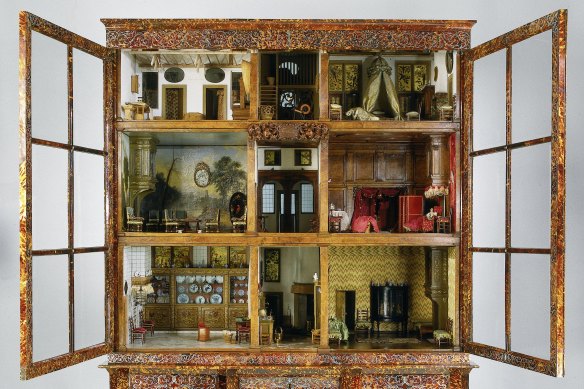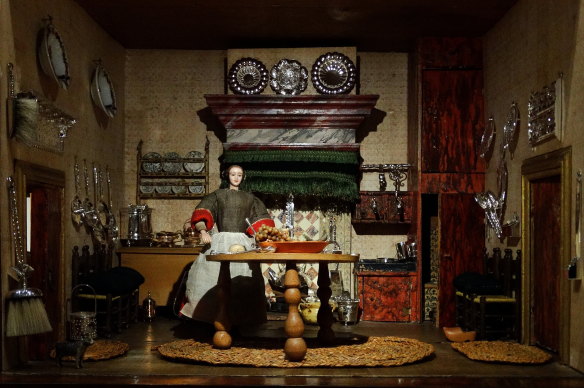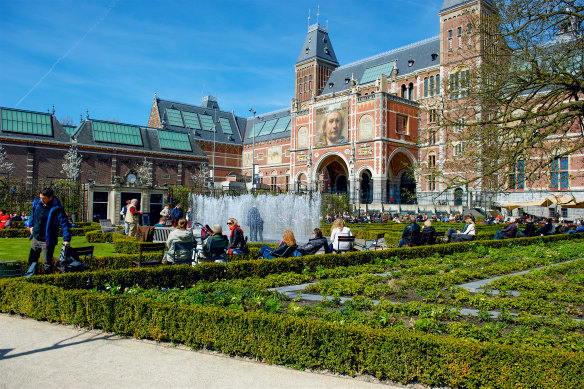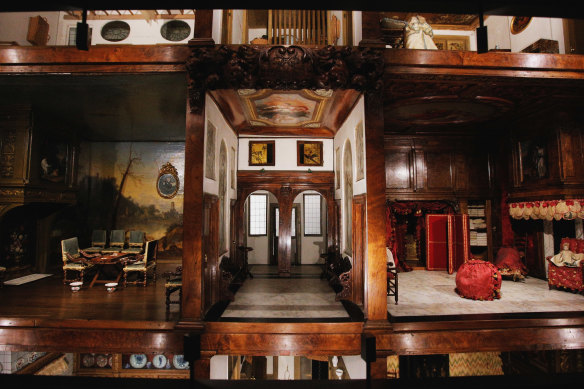Crowds are flocking to see this incredible, 300-year-old dollhouse
By Sue Wallace
There’s a crowd gathering as I wander through Amsterdam’s busy Rijksmuseum but it’s not just the big drawcards – Rembrandt’s The Night Watch, Vermeer’s The Milkmaid or Van Gogh’s Self-Portrait – that are the centre of attention.

The doll’s house by Petronella Oortman.
It’s a sophisticated doll’s house, dating back to 1686, that was owned by Petronella Oortman, wife of wealthy upper-class Amsterdam silk merchant Johannes Brandt, that’s creating a bottleneck.
Smartphones work overtime as visitors step up on a small set of stairs and stand fixated as they peer into the elaborate tortoiseshell and pewter inlaid cabinet, snapping photos and videoing madly.
There’s even a little jostling when patience wears thin amid those eager to peek into the replica of Oortman’s house that showcases tiny, detailed items made of authentic materials to exact scale.
In the late 17th century and early 18th century these dolls houses were popular among wealthy women, who lavished enormous amounts of time, money and attention on them.
It seems Oortman had plenty of cash to splash on her passion, spending 30,000 florins, the cost of a real Herengracht canal house in those days.
She also spared no expense in having miniature objects specially made. The doll’s house has a real marble floor, silk fabrics, oak and walnut inlays. All the miniature porcelain was ordered through the Dutch East India Company and made in China.

A step inside … created from oak and veneered with tortoiseshell and pewter.
Even the folded linen in the petite upstairs attic was specially woven with Oortman’s initials on it. The flat iron is made from real iron, copper and wood, a die in a small board game of Tric-Trac is ivory and the library has 84 leather-bound books.
Cabinetmakers, glassblowers, silversmiths, basket-weavers and artists were commissioned to furnish the exquisite doll’s house while successful Dutch artists painted murals in the games room and tapestry room.
Dutch artist Jacob Appel also captured it on canvas in 1710 and it now hangs in the Rijksmuseum.
It was also the inspiration for the bestseller The Miniaturist by British actress and author Jessie Burton, after she visited the museum while on holidays in Amsterdam in 2009. It was followed by a popular television drama series of the same name.
So, what’s the fascination?
The Rijksmuseum’s Curator of Furniture, Alexander Dencher, says the doll’s house is an incredible work of art.
“It is one of the absolute highlights of the collection of furniture and one of the stars of the museum,” he says.
“The doll’s house presents visitors with a world unto itself – it is not difficult to imagine yourself walking through the rooms and using the objects on display. There is an intimacy to these spaces that moves people. It speaks to visitors on various levels: artistic, personal and imaginary.

The Rijksmuseum in Amsterdam, the Netherlands.Credit: iStock
“There is no doll’s house of similar age that matches Petronella Oortman’s in terms of extravagance and costliness.”
Dencher says the doll’s house also provides glimpses of the way people lived.
“Many objects used in daily life that have perished over time have survived in the doll’s house, including wicker baskets, household utensils and even diapers,” he says.
Made by a French cabinetmaker who worked in Amsterdam for several years, Dencher says it was even an attraction shortly after it was made.
“Various accounts exist of people – mostly men, amazed by this wondrous world in miniature,” he says.

Home, sweet miniature home.Credit: Getty Images
“Nowadays people tend to think of dolls houses as playthings, but Petronella Oortman’s doll’s house was a serious work of art and could be called the female equivalent of a collector’s cabinet, which is more often associated with men.
“It really is an idealised representation of a domestic household of the Dutch elite in the late 17th century.”
I double back in the late afternoon when the crowds have shrunk and take my time staring at the highlights of the tiny well-ordered prosperous Dutch household.
Divided into nine compartments including six larger rooms, the detail is fascinating with a focus on the world of women, including life behind the scenes reflected in the laundry and kitchen.
Here, the saying good things come in small packages certainly rings true.
The writer was a guest of the Conservatorium Hotel and the museum.
THE DETAILS
Fly
Emirates operates multiple daily flights from Sydney, Melbourne, Brisbane and Perth to Dubai and daily to Amsterdam. See emirates.com
Visit
Adult entry to The Rijksmuseum is €22.50 ($37), children up to 18 free. Open daily, 9am-5pm. See rijksmuseum.nl
Stay
The impressive, renovated Conservatorium Hotel, a former bank and Music Conservatorium, is in the Museum Quarter, a short stroll from the Rijksmuseum. From €779 ($1280) a night for a duplex room based on double occupancy. See conservatoriumhotel.com
More
iamsterdam.com
Sign up for the Traveller Deals newsletter
Get exclusive travel deals delivered straight to your inbox. Sign up now.